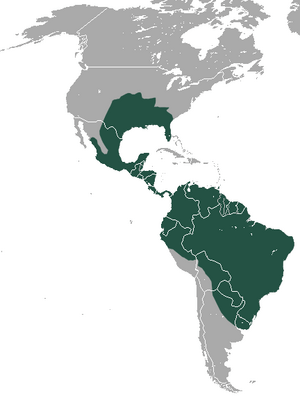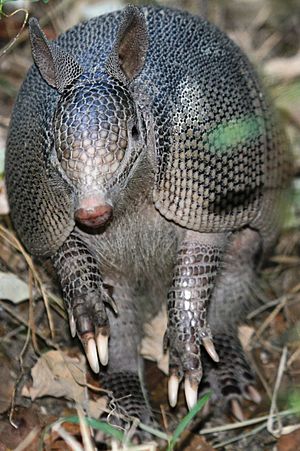Nine-banded armadillo facts for kids
Quick facts for kids Nine-banded armadillo |
|
|---|---|
 |
|
| Conservation status | |
| Scientific classification | |
| Kingdom: | |
| Phylum: | |
| Class: | |
| Order: | |
| Family: | |
| Subfamily: | |
| Genus: | |
| Species: |
D. novemcinctus
|
| Binomial name | |
| Dasypus novemcinctus Linnaeus, 1758
|
|
 |
|
| Nine-banded armadillo range | |
The nine-banded armadillo (Dasypus novemcinctus) is a special type of armadillo. It's also known as the nine-banded, long-nosed armadillo. These animals mostly eat insects and other small creatures. Their favorite foods are ants, termites, and other tiny invertebrates. When an armadillo gets scared, it can jump about 3 to 4 feet (90 to 120 cm) straight up in the air!
Contents
Where Nine-Banded Armadillos Live
The nine-banded armadillo is spreading across the United States. It is moving further north and east. These armadillos first came into the U.S. from Mexico in the late 1800s. Around the same time, people also brought them to Florida.
By 1995, you could find them in many states. These included Texas, Oklahoma, Louisiana, Arkansas, Mississippi, Alabama, and Florida. More recently, they have been seen as far north as southern Nebraska, Illinois, and Indiana.
Armadillos are spreading quickly for a few reasons. One big reason is that they don't have many natural predators in the United States. Also, people in America usually don't hunt or eat armadillos.
Outside the U.S., nine-banded armadillos live in Central and South America. You can find them from northern Argentina all the way to Uruguay.
What Nine-Banded Armadillos Eat
Nine-banded armadillos are mostly insect eaters. They find their food by pushing their long snouts into the soil. Then, they dig to find tasty treats.
They often dig up grubs, beetles, ants, termites, and worms. Sometimes, they also eat small amphibians or reptiles. They might even eat fungi or dead animals, which is called carrion.
How Nine-Banded Armadillos Behave
Nine-banded armadillos usually live alone. They are nocturnal, which means they are active at night. During the day, they rest in their burrows.
Their burrows are like long tunnels. They are about 8 inches (20 cm) wide and can be 7 feet (2.1 m) deep. Some burrows can even stretch for 25 feet (7.6 m) underground!
Armadillos often mark their territory to let other animals know it's their space. Remember, they can jump 3 to 4 feet (90 to 120 cm) when scared. This can be dangerous near roads, as they might jump into the path of a car.
Reproduction and Life Cycle
Armadillos usually mate in the summer, from July to August, in the Northern Hemisphere. In the Southern Hemisphere, they mate from November to January.
After mating, a single egg is fertilized. This egg then does something very unique: it splits into four identical embryos! Each of these embryos grows its own placenta. This means that nine-banded armadillos always give birth to four genetically identical quadruplets. They are like natural clones!
After they are born, the four baby armadillos stay in the burrow. They drink their mother's milk for about three months. Then, they start to go out with their mother to find their own food. After about six months to a year, the young armadillos leave to live on their own.
A female armadillo can have many babies in her lifetime. She might produce up to 56 young over the years.
Images for kids
See also
 In Spanish: Armadillo de nueve bandas para niños
In Spanish: Armadillo de nueve bandas para niños








